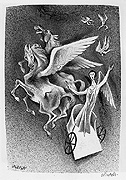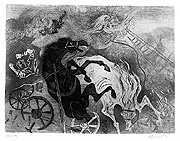| Caprichos-
--1953-56.
As
a "subversive" artist, Gropper was called in to testify before the McCarthy
committee. His name was displayed on the front pages of the country's newspapers,
galleries stopped exhibiting his work and patrons stopped buying it. Intimidation
by government agents, threats and more followed. His response to this ordeal was
to create a series of 50 lithographs under the title Caprichos, after Goya
whom he greatly admired. The works were an outlet for his frustrations as well
as an indictment of the world which gave rise to the phenomenon of a McCarthy.
Gropper's nightmarish imagery unflinchingly depicts the inequalities of society
with the hypocrisy and insensitivity that informs it. As corrosive and victrolic
as Gropper's cartoons, these works differ in that they yield their full meaning
after repeated viewing and contemplation. "The
Caprichos, however, have far more distortion and exaggeration, bolder foreshortening,
and more striking angles than is usual in Gropper's paintings. The laws of gravitation
are suspended; bodies fly, float, leap. The human form undergoes a dislocation
in its anatomic structure, as well as in shape, motion, and position. Gropper
took advantage of all the technical resources of the lithographic medium: he worked
directly into the stone, utilized the full range of tonality from the softest
grays to the deepest blacks, created sharp contrasts of chiaroscuro, white and
black lines in endless combinations. As a result the emotional impact of the Caprichos
is pervasive and at times gripping, incisively conveyed by the draftsman's virtuosity."—Louis
Lozowick, William Gropper, Associated University Presses, 1983. | |













